The Crucial MX300 750GB SSD Review: Micron's 3D NAND Arrives
by Billy Tallis on June 14, 2016 9:00 AM ESTRandom Read Performance
The random read test requests 4kB blocks and tests queue depths ranging from 1 to 32. The queue depth is doubled every three minutes, for a total test duration of 18 minutes. The test spans the entire drive, which is filled before the test starts. The primary score we report is an average of performances at queue depths 1, 2 and 4, as client usage typically consists mostly of low queue depth operations.
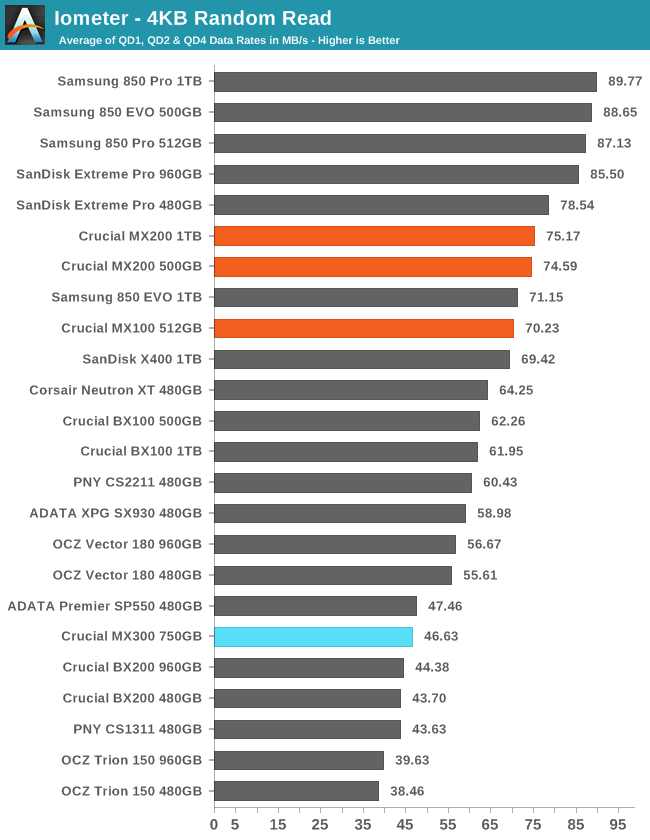
The random read performance of the MX300 is a major regression relative to the MX200, which is a disappointment given that both the SanDisk X400 with planar TLC and the Samsung 850 EVO with 3D TLC manage to perform close to the MX200's level. Since these scores are based on performance at low queue depths of reads that cannot be cached, they reflect an inherently high read latency of Micron's 3D TLC.
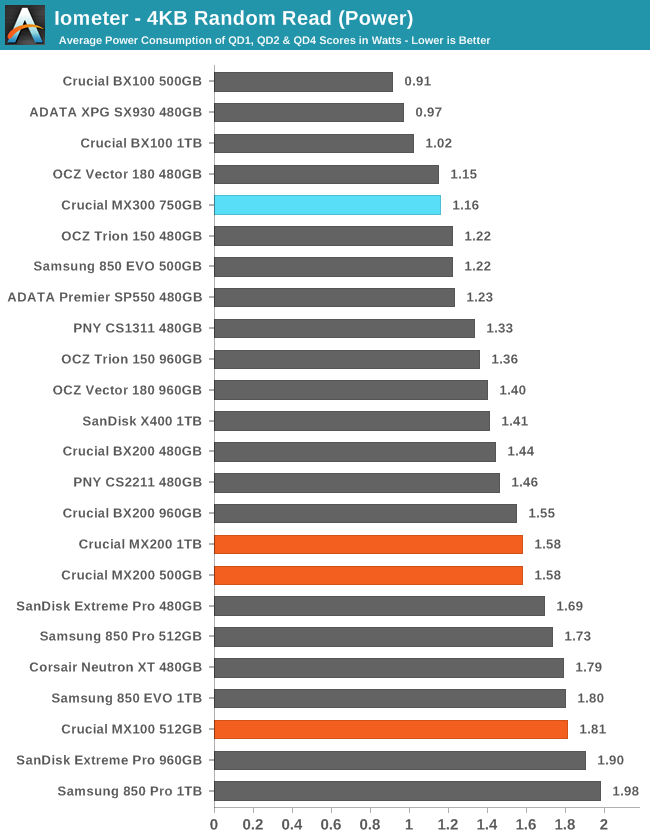
Despite the MX300 being close to the top of the power usage chart on this test, the poor performance means that the efficiency is not that great considering.
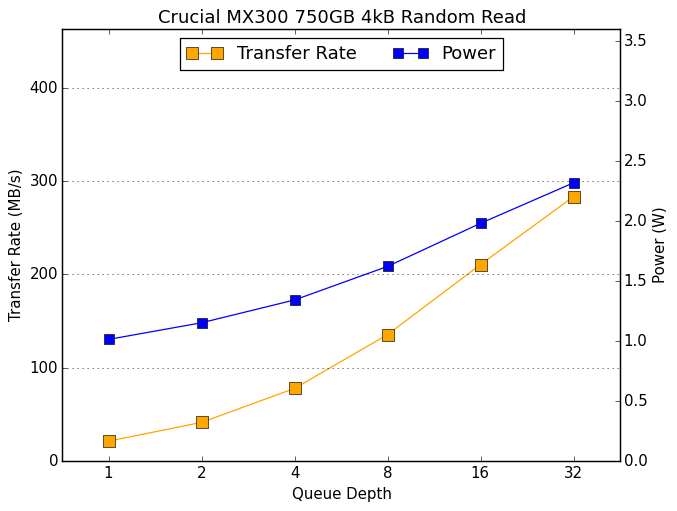 |
|||||||||
The MX300's random read performance does increase with queue depth, but not fast enough for it to catch up to the competition or reach a plateau.
Random Write Performance
The random write test writes 4kB blocks and tests queue depths ranging from 1 to 32. The queue depth is doubled every three minutes, for a total test duration of 18 minutes. The test is limited to a 16GB portion of the drive, and the drive is empty save for the 16GB test file. The primary score we report is an average of performances at queue depths 1, 2 and 4, as client usage typically consists mostly of low queue depth operations.

The MX300's random write speed is slightly worse than the MX200, but it is still quite clearly in MLC territory well above the performance level of planar TLC drives.
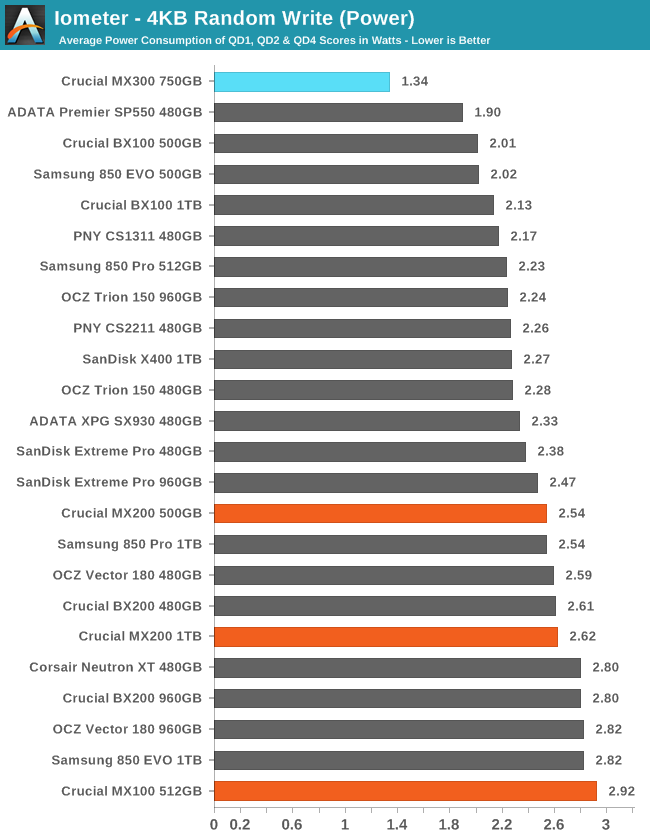
The MX 300 breaks the power usage record by a shockingly wide margin. Since this average is based on the first 9 minutes of the test, the drive is mostly writing to its SLC cache, which it can apparently do with very little power.
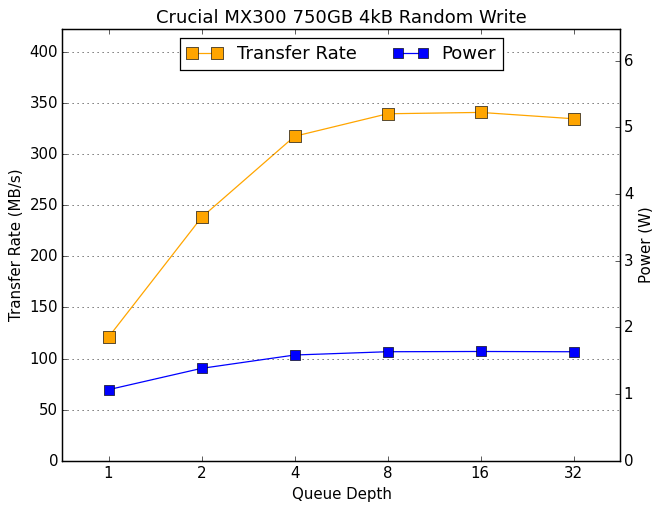 |
|||||||||
Performance scales very well from QD1 to QD4, but the limit reached by the MX300 is slightly lower than the fastest competitors and there's a slight drop at the end suggesting that the SLC cache began to run out.










85 Comments
View All Comments
fanofanand - Tuesday, June 14, 2016 - link
Slower and more expensive than the competition. Bravo Micron/Intel! Bravo!ddriver - Tuesday, June 14, 2016 - link
They have no choice but to get realistic about the price.TheinsanegamerN - Tuesday, June 14, 2016 - link
Other SSD manufacturers are living in la-la land then? Because other OEMS seem to have no trouble selling SSDs for less.Arnulf - Tuesday, June 14, 2016 - link
They should get realistic about their naming as well - this is clearly a BX300 ... Or perhaps a BX298.32, given more crappy performance considering the BX100 ...Oxford Guy - Friday, July 8, 2016 - link
The drive beats the 850 EVO in the power consumption (except idle) tests, though. So, if the drive is going to be used in a laptop that doesn't idle much it could be a potential choice over the Samsung based on that.barleyguy - Tuesday, June 14, 2016 - link
I was hoping it would be faster than the MX200. I have 3 of those.It's top of the charts in power efficiency though, so it might be a great choice for a laptop. The performance difference is probably barely noticeable in real world use, but the battery life advantage might be tangible.
Also, launch price is $199 for 750 GB, which is not bad at all.
chrisso - Friday, June 17, 2016 - link
I also use an MX 200,which actually only has a write speed of 330.I suspect launch price is a suits guestimate at selling point.
Real world differences are indeed minimal, price will be the main selling point later for the mainstream crowd (me).
chrisso - Friday, June 17, 2016 - link
(my drive IS the humble 256 gig, btw). I would buy a 750 later as pointed out,prices are a tumbling.eek2121 - Tuesday, June 14, 2016 - link
Prices quoted are MSRP, as an example, the Trion 150 listed above debuted at 38.5 cents per gb. Don't be surprised to see this drive drop below 20 cents a gig in a few months.Gondalf - Wednesday, June 15, 2016 - link
Strange comment. Anandtech article is not negative at all about this SSD driver, Techreport too says "recommended" at the end of the review.So you are a little biased in my opinion.